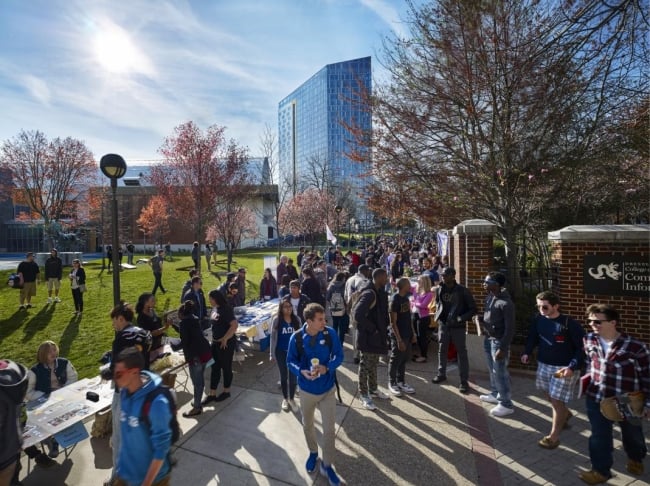You have /5 articles left.
Sign up for a free account or log in.

Creative Commons/Wikimedia Commons
Even as most colleges and universities proved over the last 17 months that they could function adequately and often effectively with their people physically dispersed, many students and employees hankered to return to their campuses. The vast majority of institutions plan to operate this fall more like they did in 2019 than they did a year ago, but that doesn't mean their leaders aren't rethinking how they might use their physical spaces in the years ahead.
Few are confronting the questions as directly as the University of Akron, which announced in February that it would consider selling, repurposing or otherwise rethinking the use of up to one million of the roughly eight million square feet of buildings and land it owns. COVID-19 didn't start the conversations at Akron, which were driven in part by enrollment and financial pressures. But as is true in many corners of our lives, the pandemic accelerated the university's discussions.
A recent episode of The Key, Inside Higher Ed’s news and analysis podcast, examined Akron’s approach and larger questions about the future and value of the physical college campus. While this conversation focused on how colleges and universities might use their campus spaces as their needs and those of their students evolve, it also explored the ability and inclination of colleges to adapt to changing circumstances.
The guests were Nathan Mortimer, vice president of operations at Akron; Lander Medlin, executive vice president of APPA: Leadership in Educational Facilities; and Tomas Rossant and Alex O'Briant, a design partner and a principal, respectively, at Ennead Architects, which works with colleges across the United States on their design needs.
An edited transcript of the conversations follows.
The Key: What went into the University of Akron’s decision to rethink its physical holdings?
Nathan Mortimer: The university has been doing quite a bit of work around properties for the last three or four years. We had buildings that we were no longer using, so we abated them and remediated them for environmental concerns, and then we green-spaced them. So we've done probably 300,000-plus square foot of abating and razing old structures in the last three or four years, just getting the campus ready for what we're doing now.
The Key: What factors have led you down that path?
Mortimer: We've had an enrollment challenge here for a number of years, so we're trying to rightsize campus to what we think enrollment is today and what we hope it's going to be going forward. It was an opportunity to take quite a bit of deferred maintenance off the books. And it's to bring some different eyes on campus to look at what we're doing and to maybe give us some different perspectives and views of how we could do things better.
The Key: Can you describe what the range of all this space is? Is it land, is it already built facilities?
Mortimer: If you were look at it a couple of years ago, it would have been largely buildings. Like I said, we had a number of vacated, unused buildings that we knew ultimately weren't in condition to be repurposed. So we took the initiative to abate those buildings, taking them down and creating green space. We've done that to roughly six buildings over 300,000 square feet that we think is ready for either selling or redevelopment.
Some buildings we've already repurposed. The State Highway Patrol in Ohio was looking for a new home in Summit County. So we actually put them in an existing building. They're not on campus patrolling our campus, but it gives us a little bit of added value of enhanced security presence, and it found a place for a partner here in the state of Ohio.
The Key: Akron's hardly alone in having built up its campus a good bit in recent years. Did universities like Akron overbuild their physical campuses, or were they responding appropriately to the context at a certain time and are now responding differently to a new context and landscape?
Mortimer: I'm probably in best position to talk just about the University of Akron versus others. But at the time, our campus was really outdated, and if you'd been on campus 20, 25 years ago, you would witness a lot of old, tired buildings. And so the university made a decision back in the late ’90s, early 2000s, to renovate campus, and it did that, in anticipation that enrollment would do different things than what it's done for us the last 10 years.
The Key: How if at all did the pandemic affect your thinking about this? Do you expect more inclination for people to work remotely, for students to learn remotely? How much did the changes and the sort of environment brought about by COVID-19 affect this process and the university's thinking?
Mortimer: Some, I’d say. I think that the further that we get into the pandemic and emerge to the new norm, I think we'll have a real better perception or realization of what the pandemic meant in terms of workplace environment and remote learning. I think we're still a little bit too close to the pandemic to know where it's going to end up. We were doing a lot of things with buildings and properties and space utilization, before the pandemic. I think we're just going to be a little more intentional as we navigate through the pandemic, looking to see what the academic program's going to look like, and certainly going to take that into consideration.
The Key: How much is this a contraction of the physical campus at Akron versus a realignment with what the university's priorities are at this moment and, ideally, ahead?
Mortimer: It's really about trying to rightsize the footprint of campus to get with what we think we need, and what the future holds, knowing that the pandemic and how we emerge from that could impact us even more. But a lot of it is just creating opportunities to clear some properties up. We're also making some investments. We have two existing very important academic buildings that are very dated, and we're getting ready to take one of those down and fully renovate the other building and put a small addition on.
The Key: What are the finances of all this likely to look like? Obviously, the university, in part because of a sizable decrease in enrollment, has had to make a bunch of difficult decisions around other parts of the university budget, staffing and some other things. Will the reassessment of the physical footprint change the financial picture enough that other cuts might not be necessary?
Mortimer: I'll be able to answer your question more fully in about seven months when we're through the process. It's about rightsizing, and the deferred maintenance item that we talked about that's on the books, which is really a cost avoidance down the road.
The Key: Tell us a little more about how Akron is thinking about the role of the physical campus going forward, and what do you think other institutions might draw from the conversations going on there?
Mortimer: The pandemic is going to lead higher education, and the private sector as well, into the same conversation. Higher ed, at least at this point, we're not just bricks and mortar. It is a place, a living place, and the living-learning experience the students have on campus, we think, is hugely important. Remote learning, I think, is going to have a new place, whether it's fully online or a hybrid or the like, but having that place for students to come, live, learn and grow is important.
The Key: So it's not a diminution of the importance of campus, as much as making sure that the campus is the right size and has the right elements to continue to fill that mission at a time when some things are changing.
Mortimer: That's right. There is a lot of fluidity out there right now, but we do believe that whether we're talking 10 years ago, today or into the future, we believe that physical environment of a campus is important to student learning and success.
The National Picture, With Lander Medlin
The Key: Lander Medlin is executive vice president at APPA, the main association of educational facilities professionals. Lander, I'm curious how what Akron is doing fits into the larger national landscape that you look at in your job, and how representative it is of conversations elsewhere.
Lander Medlin: What I'm hearing from other campuses across the country is they need to meaningfully downsize, rightsize their physical campus. The data is not pretty when it comes to being able to support a drop in revenues, net revenues, a drop in enrollment. But also, the increase in actual need to repair and maintain and replace these facilities, that's increasing … Just like humans, buildings age, infrastructure ages. We need to keep up with our investments around that. And we've not done that, unfortunately, in the main. And so we have an increasing need. This actually can be an exciting time because these issues existed pre-pandemic. We have real opportunities, and I think Akron is an example of that.
The Key: What is your early sense of how the pandemic influenced the thinking of your members and of college leaders about their physical space? I've seen it argued both that it increased the value of the physical campus and that it revealed the campuses to be less important. How do you think most college officials that you talk to are thinking about it?
Medlin: The remote hybrid workplace and remote hybrid learning are going to give us some advantages to utilize remote for those individuals who want to stay that way. Then we have the idea of place-based institutions, and how important it is. Two-thirds to three-quarters of the students said they wanted to come back, even in the midst of last fall. And their parents drove them all the way across the country to get there, too.
So I think that institutions are looking at being more intentional about their sense of place. And that's going to drive being more intentional and disciplined about what spaces we want to keep. We don't want to demolish anything, do we? But we are overbuilt.
Place does matter, and I think it's going to continue to matter. I just think it's how do we consider our own competitive advantage by institution, and how do we consider utilizing that as the differentiator for who is our audience?
How do we go at the spaces that are no longer attractive to the communities that we're trying to bring in? I'll give you a perfect example, and that's large lecture halls. Are people going to build large lecture halls after the remote synchronous-asynchronous delivery? I don't think so. And so now what do we do with those things? And how do we move forward very differently with smaller sort of learning pods?
The Key: It sounds like this is very much an institutionally focused equation or set of questions. So what kinds of questions do you advise institutions to be asking, and what kind of analysis should they be doing to assess whether they've got the right physical footprint, the right mix of space and facilities for where they are now and for where they're heading?
Medlin: Part of this is stepping way back and thinking about my institution, what differentiates my institution from everyone else? How do they use that to advantage? What is their competitive advantage, given those differentiations? If I know what that is programmatically and academically, then I know where I want to head in terms of my population of students and faculty.
And it also helps drive programmatic space. Where are the biggest drivers for using my space for enrollment, recruitment and retention? And how do I use that to make forced, disciplined decisions around, let's call it a net-zero space policy. I know, it's scary to people. How do I actually think about, “I am not going to add space”? We are going to make conscious decisions about either reducing our space portfolio, or we're going to be very targeted about what space we're going to use.
The Key: We may be heading into a period in the next year or so where there isn’t quite as much financial pressure on colleges as there’s been. How do you think about the compulsion institutions might or might not feel in the next year or two to undergo the sort of rigorous analysis and potentially difficult decisions around use of the campus? Do you sense a willingness or commitment to doing hard things even if pressure on institutions eases somewhat?
Medlin: I remain hopeful, let me say it like that. The worst thing we can do is get lulled into the short-term gains of maybe we get some federal one-time investment of monies. I actually think that enrollment will come back in the fall, right, at many of these institutions. But the enrollment cliff is real. Go to Nathan Grawe's piece on the agile college and the previous work. It's coming.
The worst possible thing we can think is, “Well, let's just wait it out, and we'll get back to normal.” There is no get back to normal. That's why I commend the University of Akron in their work, because they are shedding themselves of a lot of space and trying to firm up who they are, what they are about.
The Key: Is there something you saw emerging from the very difficult last 15 months that makes you hopeful that colleges can step up with this challenging set of decisions?
Medlin: Something we learned during the pandemic, one of the best practices was around collaboration. The silos were broken -- facilities talking to academics, talking to student affairs, to finance. Everybody was part of the team. We had a purpose -- get students back. Now we have to rally around that next purpose, and that is, we are going to collaborate to actually reduce the physical footprint of these institutions.
Design and Campus Spaces
The Key: Our next guests are Tomas Rossant and Alex O’Briant of Ennead Architects. As people who watch this space closely, how typical or not is Akron of conversations you hear unfolding on campuses around the country?
Tomas Rossant: Most of our clients are top-tier public research universities or top-tier private universities and colleges, so the notion of de-acquiring and giving away real estate is being talked about, but nowhere near to the degree that you mentioned at Akron. We can report that among the kind of healthy institutions of higher education, there's kind of a nervous excitement about tinkering with the business model, with the real estate model, with how we teach, with where we teach, to really make their institutions even stronger.
The Key: There's obviously lots of talk about remote work and talk about reshaping the learning environment such that possibly more students study in realms other than in a physical classroom. How do the institutions you work with view those possibilities?
Rossant: I think everybody is very excited about the trends and scratching their heads about how do we change, not only our spatial utilization, but what spaces we own, what spaces we operate, where those spaces are. I spoke last week with a law school dean who has a state-of-the-art law school. And he wanted to pick my brains. He wants to open a second law school at the same university, and that law school is going to have a lower price point. It's all going to be remote, except for the kind of minimal communal aspects of learning law. It will be a very small building, right? Students will come to it maybe twice a semester, or four times a semester. Can you imagine that -- a university with two law schools? So people are really trying new things.
Alex O'Briant: I think universities are looking somewhat separately at the work space issue and the classroom and pedagogical issue. On the classroom side, I think the move is going to be further toward the kinds of things that have the most value in person. That's the thing we've learned, is that we can be remote sometimes, but we need to be face-to-face, so I think the emphasis is going to be on experiential learning, teamwork, face-to-face projects. This is a trend that precedes COVID that's moved more toward experiential learning and away from big lecture halls. It's almost like the pandemic just sort of pushed us over the ledge and sort of encouraged us to just go ahead and embrace this new direction and start to rethink space more holistically and strategically out of necessity.
The Key: What are the issues you encourage campus leaders to be thinking about as they engage with questions of whether they have the right amount of space, and the right space? Is there a framework you use as you work with colleges on these issues?
Rossant: Space is money. And the first question we often ask is: What type of accurate visibility do you have into your spatial utilization? We're finding that relying on the registrar to say this is how often this room is booked, this is how often this seminar room is used, is very spotty, because it relies on simplistic information, like someone booked it. But they don't know if someone actually used it, nor do they know how it was used. We like to try to encourage institutions to get much more accurate information, either by using digital technology, or the old-fashioned way, the way that master planners do -- you hang out for a long time and you take a lot of notes. But you can't make strategic changes to your physical campus without accurate data as to how it's used.
The next step is really to understand institutional vision for the future. We can't tell them where to go, right? Should our mission change and should we educate more people, either by doing some hybrid things, growing in the certain way, teaching during the summer, getting faculty to actually teach after 3:00 on Friday, and getting faculty to teach before 3:00 p.m. on a Monday? How can we actually exercise better results, better outcomes, educate more people while driving down the cost of our education? It has to start with that notion of a vision.
O'Briant: Being apart has helped focus us all on the value of being together. And I think that's the incredible moment for campuses, which are so steeped in the concept of place, and in-person learning and interaction. There is an opportunity to really evaluate where we can get the most benefit culturally and educationally from being in person, because the thing we've learned in the last year is how to not be together.
Now the value proposition for campus is what can we offer in place? These campuses are so expensive to build and maintain. So back to your question about what's next for campuses, I think you have to ask that question: What's the value of being together, and which things are more valuable than others?
Rossant: I think the real value of being in a learning culture physically in place is all the ad hoc critical dialogue, all the spontaneous interactions, what we call learning outside the classroom. And, ideally, we should still have that. Higher education should be focused on being in a place, but I think what we have ask, do I have to be in that place 24-7? Do I have to be in that place for the whole semester? Can I say, hey, this semester it's just freshmen, right, who are on campus? And this next semester, it's seniors. And what does that do to the efficacy of learning and teaching?









